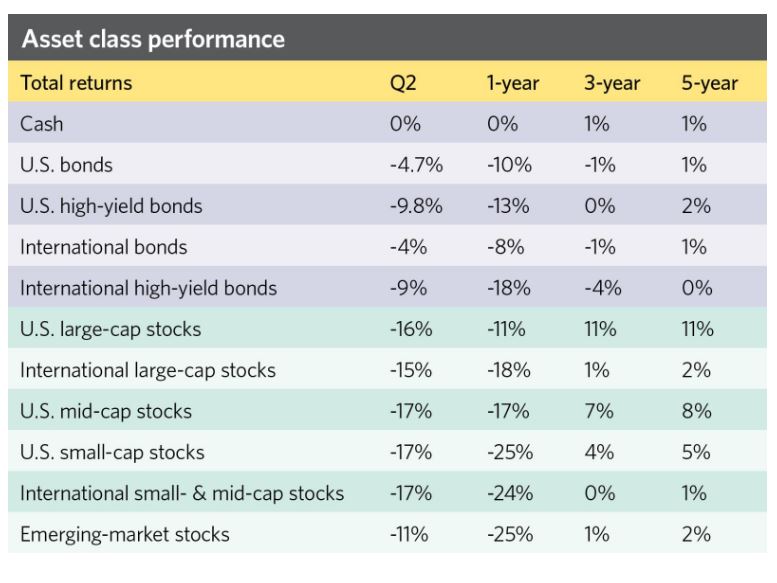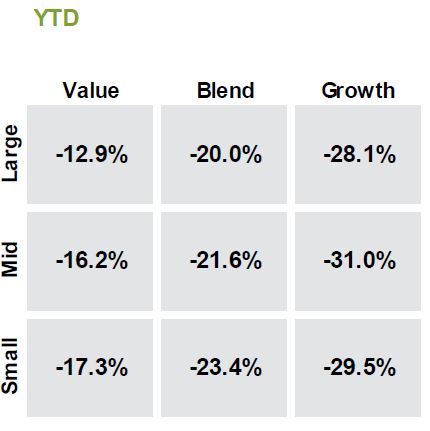Market Facts
DOG DAYS OF SUMMER – The summer months of June-July-August are ranked 9th, 5th and 11th in terms of S&P 500 performance over the last 30 years, i.e., 1992-2021.
WHAT DOES A TYPICAL BEAR MARKET LOOK LIKE? – On average, bear markets last about 13 months and fall about 34%. But those that are not associated with deep or prolonged economic downturns look somewhat different: They tend to last about 9 months and fall about 28%. While the average bear market requires nearly 23 months to recover its losses, the recovery time for bear markets during shallower downturns is about 10 months (source: Edward Jones).
YIKES! – The size of the US economy as of 3/31/2022 was $24.4 trillion. The size of the US national debt as of the same date was $30.4 trillion (source: Commerce Department).
HOW DID YOU DO? – The net worth of Americans increased +62% over the last 5 years (+10.1% per year), rising from $92.8 trillion as of 12/31/2016 to $150.3 trillion as of 12/31/2021 (source: Federal Reserve).
ARE WE SHRINKING? – Demographers use 2.1 “births per woman” as the number of births required to achieve “replacement fertility,” i.e., the number of births needed for a population to exactly replace itself from one generation to the next. Over the 50 years from 1970 to 2020, the “births per woman” for the United States has declined from 2.5 to 1.6 (source: The World Bank).
ONE THOUSAND FEWER EACH DAY – The United States had 3.658 million births in 2021, or 10,022 births per day. 20 years earlier (2001), the United States had 4.026 million births, or 11,030 births per day (source: Centers for Disease Control and Prevention).
Market Indices



Quarterly Recap
Economy – The U.S. economy continued to decelerate with manufacturing and services growth slowing. Forty year high inflation levels remained a threat to consumer spending. Higher costs regarding surging energy prices, the festering supply chain disruption, and labor challenges put pressure on corporate profits. Financial conditions firmed as the Fed accelerated its policy tightening with 50 and 75 basis point rate hike s and the beginning of its balance sheet reduction plan. Internationally, inflation pressures prompted some key central banks to tighten policy, fostering a rise in global interest rates. Meanwhile, the war in Ukraine and COVID induced lockdowns in China weighed on economic growth, although earnings estimate s continued to increase. A 20 year high in the U.S. dollar exacerbated global sentiment.
Equities – Global equities continued to fall in 2022 as higher interest rates weighed heavily on long duration stocks (high price to cash flow) which are more numerous in the U.S. Short duration stocks (low price to cash flow) continued their year-to-date strong performance, paring some of the losses and helping international stocks outperform. Investor appetite for stocks waned with the war in Ukraine and persisting inflation pressures globally that forced some key central banks to ramp up aggressive monetary policies and boosted recession concerns. Emerging markets outperformed as the continued increase in commodities benefited resource related countries, limiting the sting from slowing economic growth in the world’s second largest economy, China.
Income – The Fed pivoted to a more aggressive pace of rate hikes in the second quarter. The Federal Open Market Committee (FOMC) raised its benchmark interest rate by 50 basis points and 75 basis points at the May and June meetings, respectively, and signaled that it will continue to raise rates in order to combat inflation. Treasury yields surged given projections for a higher than anticipated ‘terminal’ Fed funds rate. Municipal bond yields rose, although fundamentals generally remain strong. The dollar continued its upward trend in the second quarter as interest rate differentials widened. Although most global central banks are raising rates, the Federal Reserve is expected to raise rates more aggressively than many other developed market central banks.
Commodities – Commodity prices were buoyed by the crisis in Europe, which saw energy, grain, and natural gas prices surge defying ongoing weakness in China and strength in the U.S. dollar. The S&P GSCI rose solidly during Q2 but was limited by sharp drops in metals prices. The pullback in metals came amid demand concerns as global central banks tried to cool the economy to combat inflation, while supplies continue to build. Th e swift rise in energy prices accelerated as demand for oil continues to outstrip supply, which has been curtailed by OPEC and a slow return of U.S. production capacity, exacerbated by the ongoing war in Ukraine and the EU agreeing to ban most Russian oil by the end of the year.
